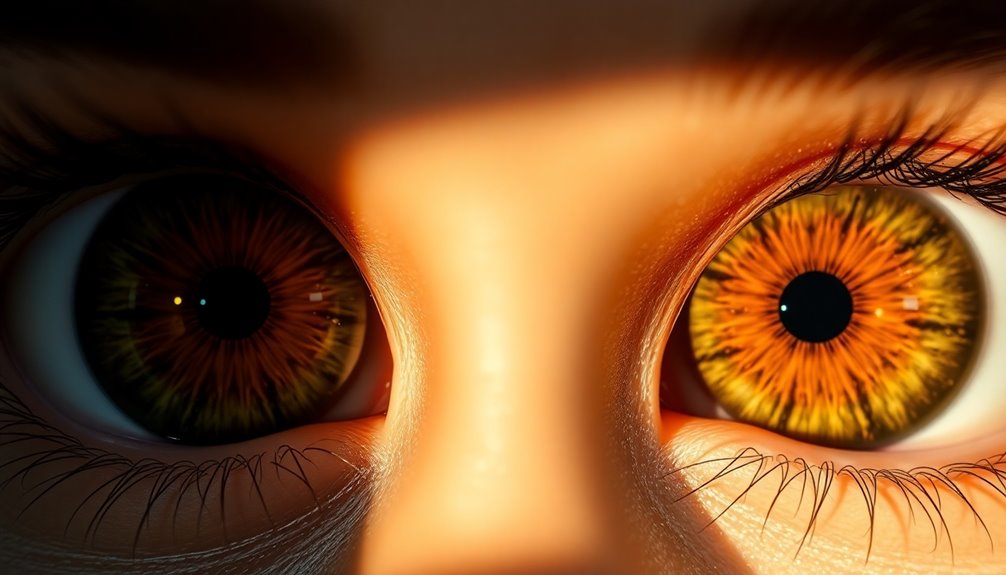Hazel eyes are truly unique, combining green, gold, and brown tones that shift with light and surroundings. This captivating color results from a complex interplay of genes that controls melanin production, creating a mesmerizing blend. Culturally, hazel eyes symbolize individuality, wisdom, and spiritual gifts across various traditions. People often perceive those with hazel eyes as warm and inviting, adding to their allure. However, keep in mind that hazel eyes can come with health risks, like increased sensitivity to UV light. If you're curious about their deeper meanings and implications, there's plenty more to uncover!
Key Takeaways
- Hazel eyes showcase a unique blend of green, gold, and brown, creating a captivating and dynamic appearance influenced by lighting and surroundings.
- Culturally, hazel eyes are often associated with beauty, wisdom, and spiritual connections, enhancing their allure in various traditions and myths.
- The genetic complexity behind hazel eyes arises from multiple genes, allowing them to appear in offspring even without direct parental traits.
- Individuals with hazel eyes may face increased sensitivity to UV light and a higher risk of certain eye diseases, emphasizing the need for regular eye care.
- The emotional depth and empathy attributed to hazel-eyed individuals foster strong social connections and enrich personal relationships.
Understanding Hazel Eye Color
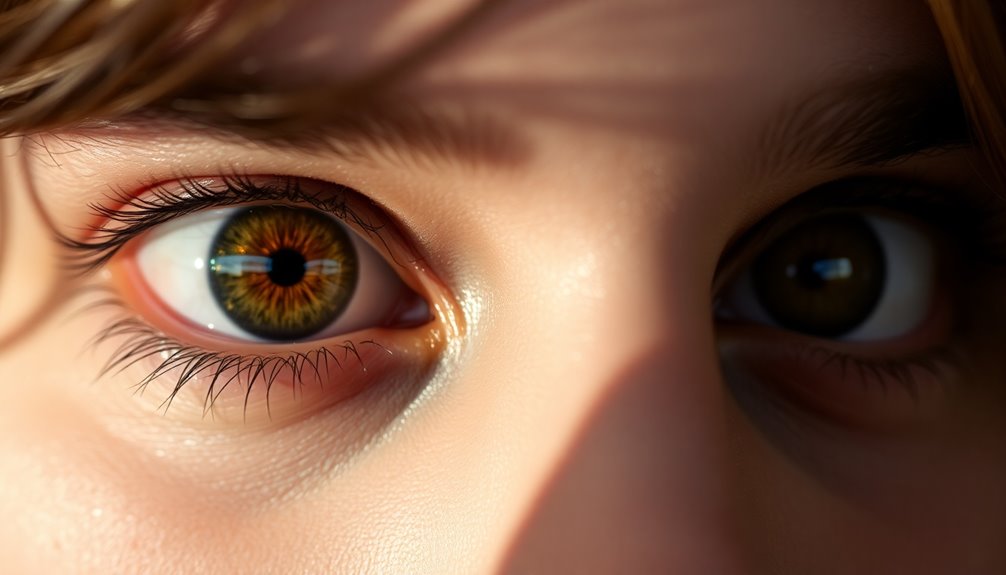
When it comes to understanding hazel eye color, you'll find it's a unique blend of green, gold, and brown tones. This captivating combination creates a stunning visual dynamic that can shift depending on lighting and surroundings. Your hazel eyes might appear primarily green one moment and then lean towards brown the next, showcasing their versatile nature. Additionally, people often find that individuals with hazel eyes, like those with black golden retrievers, are perceived as having a warm and inviting presence.
The multi-faceted patterns within hazel eyes often include flecks of blue, especially around the pupil, adding to their allure. You'll notice intricate designs, such as starburst patterns or speckles, which emerge from the uneven distribution of melanin. This irregularity is what sets hazel eyes apart from other colors, allowing them to present a captivating array of shades rather than a solid hue. Notably, hazel eyes are a polygenic trait, influenced by multiple genes that affect melanin distribution. Furthermore, the way you perceive your hazel eyes can be influenced by your vibrational state, as your emotions may reflect in how others see your unique colors. Understanding the genetics and patterns of these eye colors can enhance your appreciation of their beauty, as they often illustrate risk management strategies in the approach one takes towards personal investment in their unique features. In fact, this genetic variation is similar to how Montessori-inspired environments encourage individuality and exploration in children.
Moreover, the appearance of your hazel eyes can change with the environment. Natural sunlight may reveal different tones than artificial lighting, making the colors dance and shift.
This adaptability is what makes hazel eyes so special, as they reflect not just your unique genetics, but also the world around you. In essence, hazel eyes are a mesmerizing blend of colors that tell a story all their own.
Genetic Factors Behind Hazel Eyes

Hazel eyes result from a complex interplay of at least 16 different genes, making their genetic foundation intriguing. Eye color is a polygenic trait, meaning multiple genes are involved in determining your unique shade of hazel. Key genes like OCA2 regulate melanin production, while variants in the HERC2 gene can turn OCA2 on or off, directly affecting melanin levels in your iris. Other pigmentation genes, including TYR and LYST, contribute to the overall pigmentary profile. Interestingly, just as with eye color, studies suggest a correlation between astrological signs and perceived beauty, highlighting the multifaceted nature of attractiveness. Additionally, the AI-driven personalization in education exemplifies how complex genetic traits can be understood through advanced data analysis. The intricate nature of genetic variation also parallels the global tea market, where diverse factors influence product characteristics and consumer preferences.
You might be surprised to learn that hazel eyes can appear in offspring even if neither parent has them. This occurs because the genes responsible can be carried silently through generations, showcasing the non-Mendelian inheritance patterns at play. Additionally, environmental factors may also play a role in eye color expression, influencing how the genes manifest. In the same way, zodiac sign compatibility can provide insights into personal relationships and attraction.
Hazel eyes aren't linked to a specific sex and don't follow simple dominant or recessive rules, making their appearance unpredictable. Moreover, genetic interactions, like single nucleotide polymorphisms (SNPs) in HERC2, impact how other genes express themselves, creating a dynamic genetic landscape. The variability in melanin distribution leads to the distinctive look of hazel eyes, which can also shift with age and lighting conditions.
Melanin and Light Interaction
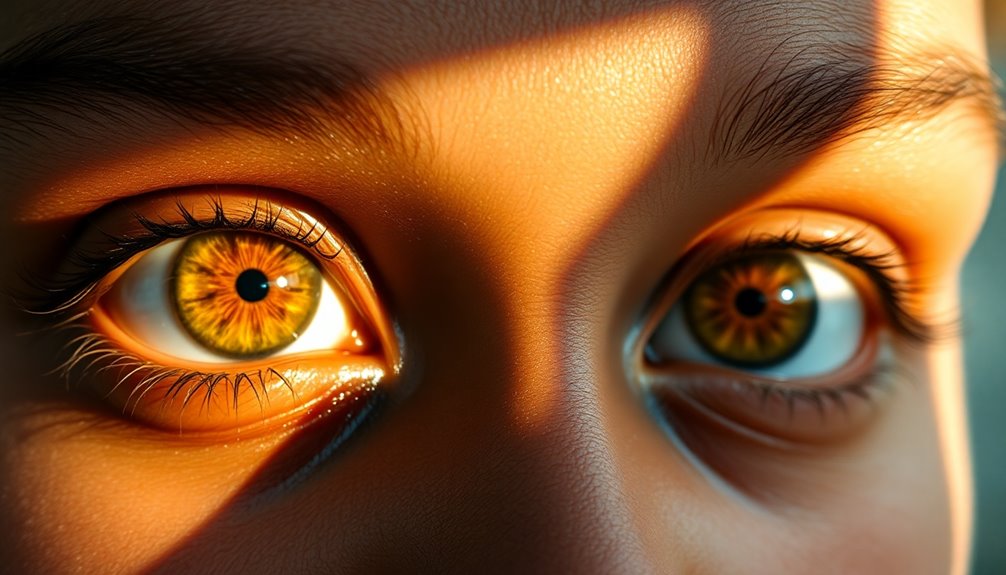
At the heart of hazel eyes' captivating appearance lies the intricate relationship between melanin and light. Melanin, the primary pigment responsible for eye color, exists in varying concentrations and distributions in hazel eyes. Unlike brown eyes, hazel eyes have less melanin in the front layer of the iris. This unique distribution creates a blend of brown, green, and gold hues, depending on how light interacts with your eyes. Interestingly, AI technologies have been developed to analyze and enhance the understanding of human eye colors. Continuous learning about eye color variations has also contributed to this understanding. Additionally, the study of water efficiency in various contexts can help us appreciate the natural beauty in our surroundings, much like the beauty found in hazel eyes.
When light enters your eyes, melanin absorbs different wavelengths, affecting the colors you see. Shorter wavelengths, like blue and green light, scatter more easily, which contributes to the dynamic appearance of hazel eyes. In bright conditions, your pupils constrict, emphasizing the darker brown areas, while dimmer light allows the greenish regions to shine through. This constant change is a result of light absorption and scattering, showcasing the beauty of your hazel eyes. Interestingly, the presence of multiple genes has been shown to influence the range of colors within hazel eyes. The interaction of light with melanin further enhances this captivating effect, creating a mesmerizing display.
Additionally, the balance between eumelanin and pheomelanin plays a critical role in the colors you observe. Together, these factors create the mesmerizing and ever-changing look of hazel eyes, making them a true marvel of nature.
Health Implications for Hazel Eyes
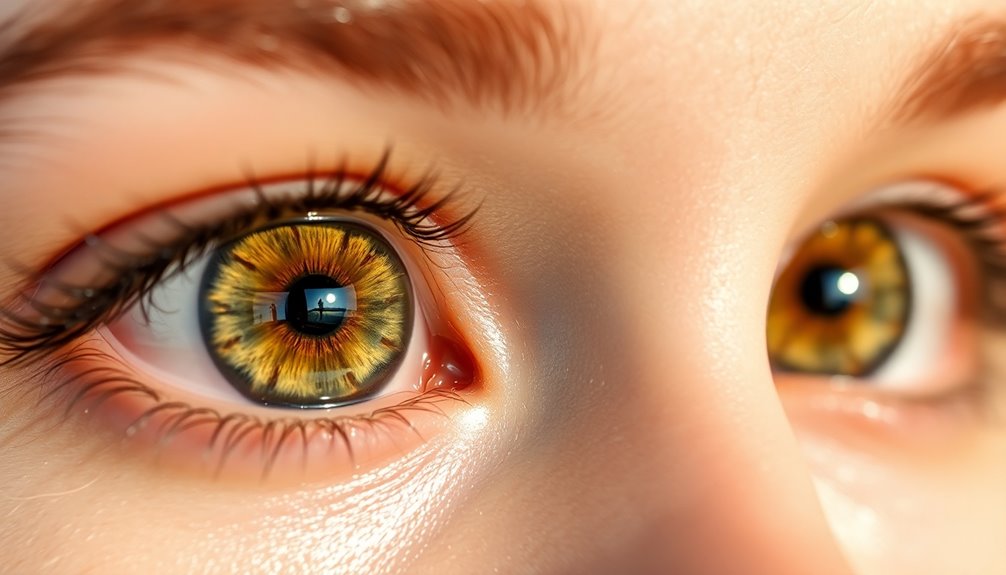
Individuals with hazel eyes may face unique health implications that require attention. Research indicates that you might be at a higher risk for certain eye diseases, such as uveal melanoma and age-related macular degeneration. Conditions like corneal opacity and cataracts could also be more likely to develop, potentially impairing your vision. Additionally, you may experience more refractive errors, including nearsightedness or farsightedness. This heightened risk is partly due to the fact that those with lighter eye colors are more susceptible to developing these conditions. Furthermore, maintaining regular eye exams can help detect issues early and preserve your vision. New studies suggest that individuals with hazel eyes may also benefit from using an air purifier with HEPA filtration to improve overall air quality and reduce allergens. It is also important to be aware that individuals with lighter eye colors may have an increased sensitivity to UV light exposure, which can exacerbate eye strain and discomfort. Studies have shown that those with breast cancer may also experience changes in vision due to treatment effects.
Beyond eye health, hazel-eyed individuals are often more sensitive to UV light, increasing the risk of skin cancers like basal and squamous cell carcinoma. Therefore, it's crucial to adopt enhanced sun protection measures.
To maintain optimal eye health, consider scheduling regular eye exams at least once a year. Staying hydrated and consuming a balanced diet rich in vitamins A, C, and E can also support your vision. Additionally, wear UV-protective sunglasses to shield your eyes from sun damage and manage light sensitivity in your daily activities.
Finally, be vigilant about any changes in your vision. Promptly seeking medical advice can help you address potential issues before they worsen.
Cultural Significance of Hazel Eyes
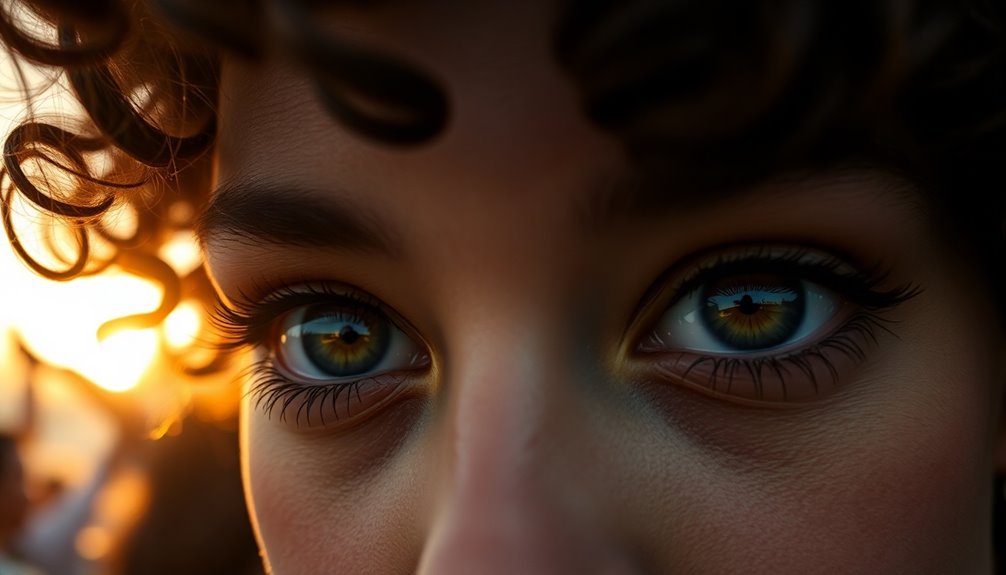
The unique characteristics of hazel eyes extend far beyond health implications; they hold significant cultural meanings across various societies. In Celtic mythology, hazel eyes connect to the sacred hazel tree, symbolizing wisdom and a bond with nature. Additionally, the symbolism of colors in different cultures adds layers to the interpretation of hazel eyes. The importance of empathy in relationships further emphasizes the deeper connections individuals with hazel eyes may foster due to their perceived wisdom.
Native American cultures see them as symbols of healing and spiritual gifts, while ancient Egyptians associate them with rebirth and resurrection. In Christian symbolism, hazel eyes reflect growth and renewal, mirroring the lushness of the Garden of Eden. Eastern traditions, particularly in Chinese astrology, link hazel to the element of wood, representing adaptability and creativity. Furthermore, the most common automotive repairs emphasize the importance of regular maintenance, which parallels the ongoing care individuals may take in nurturing relationships influenced by their hazel-eyed perceptions.
These cultural beliefs contribute to the perception of hazel eyes as symbols of wisdom, insight, and connection to the natural world. They're often viewed as mysterious, lending depth to characters in literature and media. Famous individuals like Angelina Jolie and Rihanna embody this allure, reinforcing societal ideals of beauty. Moreover, hazel eyes can impact personal identity and style, inspiring unique fashion choices that highlight their distinct colors. Additionally, individuals with hazel eyes often possess a unique blend of colors that further enhances their allure. This multifaceted significance reveals how hazel eyes not only enhance beauty but also convey a rich tapestry of cultural meaning.
Frequently Asked Questions
Do Hazel Eyes Change Color With Mood or Emotions?
Yes, hazel eyes can change color with your mood or emotions.
When you're happy or surprised, your pupils dilate, often bringing out the green hues. Conversely, if you're feeling angry or sad, your pupils constrict, making the brown tones more pronounced.
This interaction between your emotional state and pupil size alters how light hits your irises, which in turn affects the color you see.
Are Hazel Eyes More Sensitive to Light Than Other Colors?
Yes, hazel eyes are generally more sensitive to light than other eye colors.
With lower melanin levels, they lack some natural protection against bright light and UV radiation. This makes you more prone to discomfort, glare, and visual disturbances in bright conditions.
You'll likely notice that your hazel eyes can change appearance in different lighting, making them susceptible to light sensitivity.
It's wise to wear UV-protected sunglasses to help mitigate these effects.
Can Hazel Eyes Be Artificially Enhanced With Colored Contacts?
Yes, you can definitely enhance your hazel eyes with colored contacts!
Enhancement tints deepen your natural hues, while opaque tints can give you a completely different color.
Multi-tone and natural enhancer lenses provide subtle shifts or realistic appearances, mimicking your iris patterns.
Just make sure you get a proper fitting from an eye care professional for comfort and safety.
With good hygiene practices, you can enjoy a fresh, vibrant look anytime!
What Celebrities Are Known for Having Hazel Eyes?
If you're curious about celebrities with hazel eyes, you've got plenty of stunning examples.
Rihanna's hazel eyes feature flecks of green and brown, while Zendaya's are dominated by golden tones.
Lady Gaga blends gold and greens beautifully, and Mila Kunis captivates with her mix of colors.
On the male side, David Beckham and Tom Cruise showcase striking hazel eyes too.
These celebrities highlight the unique allure that hazel eyes can bring to their looks.
Is There a Correlation Between Hazel Eyes and Certain Personality Traits?
You might notice a correlation between hazel eyes and specific personality traits.
People with hazel eyes often exhibit creativity and a strong sense of determination. They're emotionally expressive, experiencing feelings deeply, and can adapt easily to different situations.
This versatility makes them fun-loving and spontaneous. You might find that those with hazel eyes are also protective of their loved ones, showcasing a blend of independence and compassion in their interactions.
Conclusion
In conclusion, hazel eyes aren't just a unique mix of colors; they reflect a fascinating interplay of genetics, light, and cultural significance. Your eye color can reveal insights about your health and heritage, making it more than just an aesthetic feature. Embracing your hazel gaze connects you to a rich tapestry of meaning, blending beauty and depth. So, the next time you catch a glimpse of your reflection, remember the multifaceted story behind those mesmerizing eyes!

